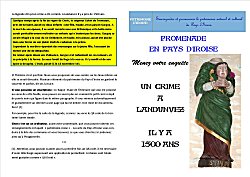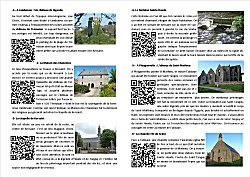
GPS : 48°32'57 N 4°42'21 W
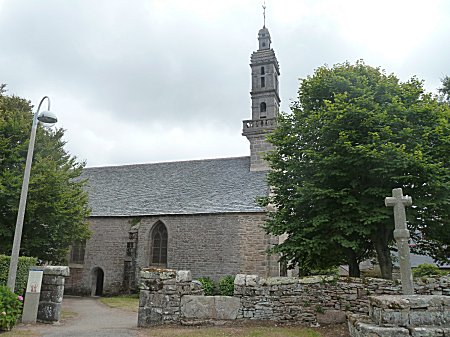
Access :
Leave St-Renan by the Ploudalmézeau road (D68) and continue straight on towards Argenton. 1.3 km after St-Roch chapel, turn right towards Landunvez. Cross the village, join the D27 and continue in the same direction until Kersaint. At the roundabout, turn right and park immediately to the right in the parking of the chapel.
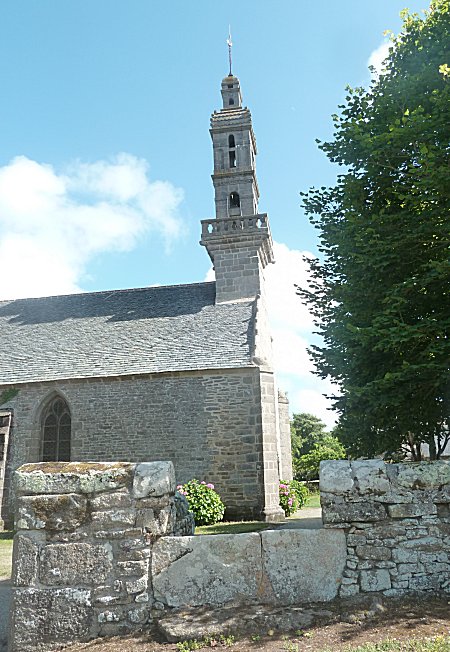
The bell tower of this chapel, with its three floors overlooking a beautiful gallery, was rebuilt in 1903. Indeed, the lightning had just knocked down the old bell tower dating from 1749 as well as part of the stained-glass windows, while the roof was seriously damaged.
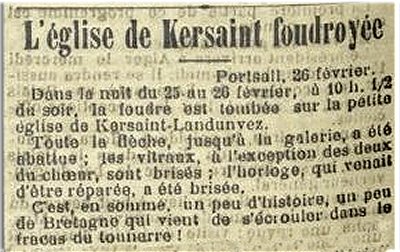
La Dépêche de Brest - February 27, 1903
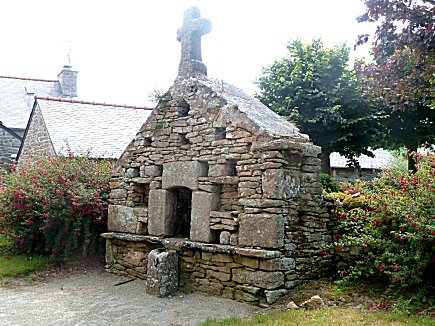
In front of the portal of the chapel stands a large stone ossuary with 13 niches for skulls. Don't worry, they're not busy ! |
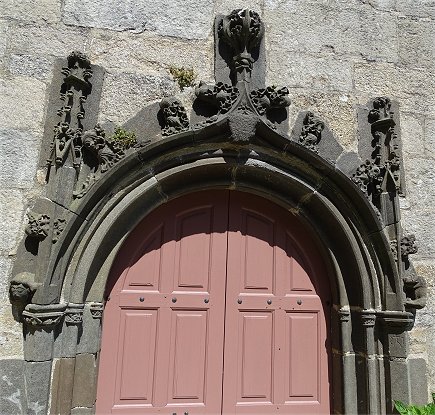
|
Particularly noteworthy is the architectural ornamentation in kersanton stone surrounding the chapel's large portal.
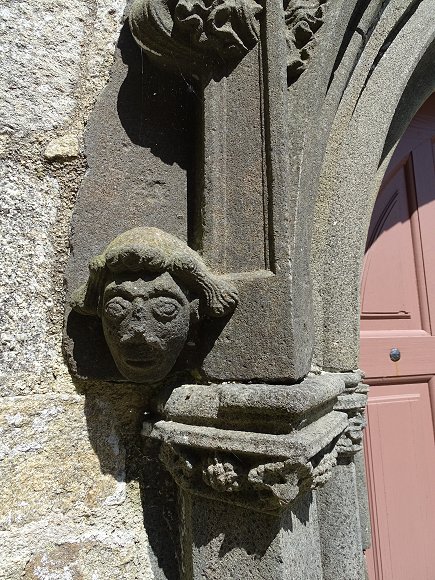
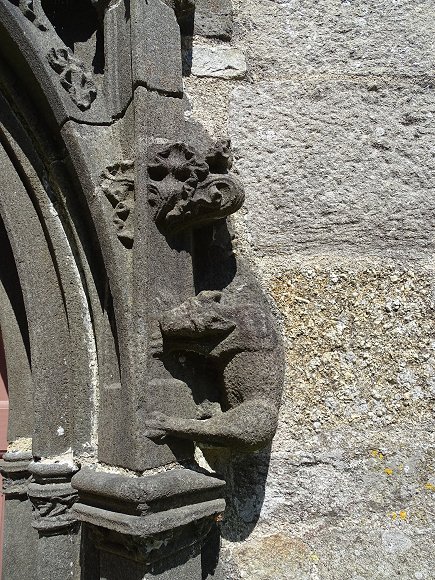
The building was built in the XVth century, when the lords of the castle of Trémazan1, the Du Chastel, were all powerful at the court of the kings of France.
It probably replaced a much earlier chapel, possibly dating back to the early Middle Ages. In fact, if you go around the building, you'll see a light-colored tombstone perched on a granite base with two small arches. It is a cenotaph, i.e. a funerary monument containing no body.
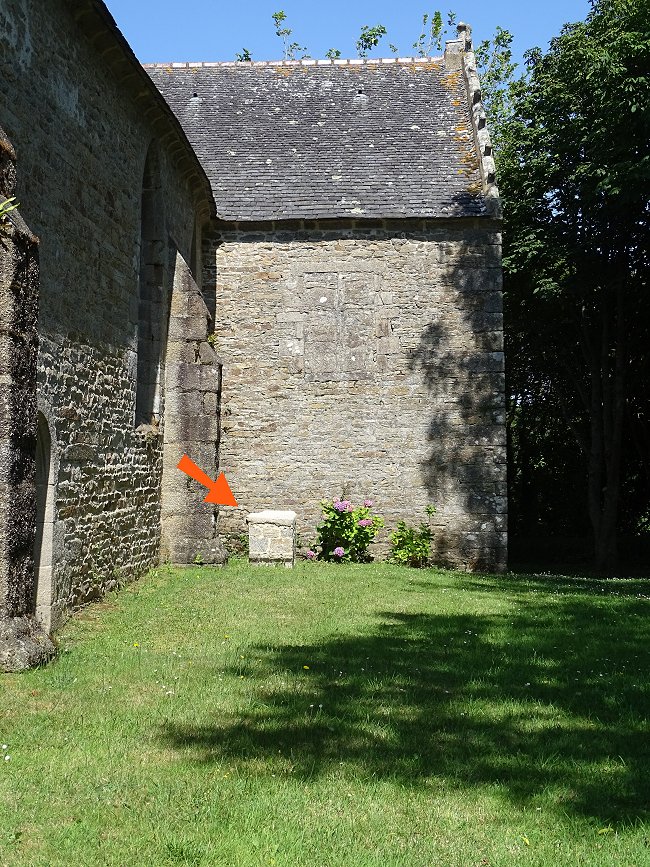
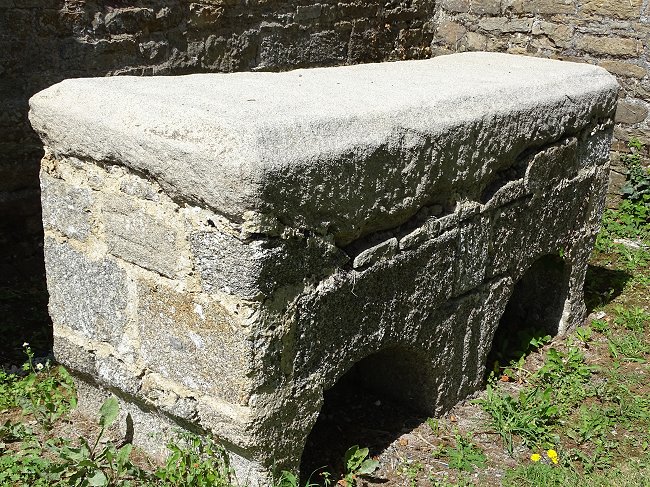
The upper slab was found on the ground in front of the chapel altar during the work that followed the destruction of the bell tower by lightning in 1903. The arcaded base that highlights it may have been part of the balustrade of the former bell tower.
Immediately below the slab is the upper, badly degraded part of the tomb.
The eroded Du Chastel coat-of-arms can be seen at the end. And along its edge, we can still see the traces of an inscription that has become totally illegible.
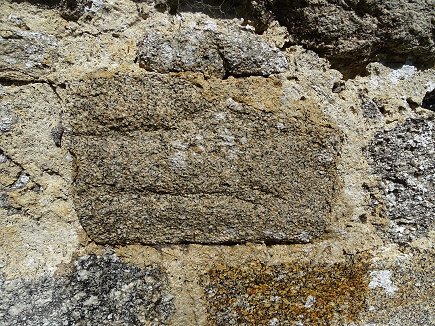
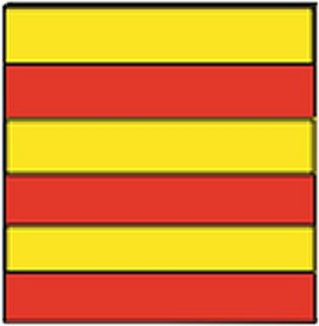
It is therefore likely that the tomb buried in front of the altar was that of one of the first lords of Trémazan, perhaps even the founder of the old chapel. This would make the stone the site's oldest vestige.
Left outside to the elements for over a century, it looks as though it will continue to deteriorate.
In 1518, by decision of Tanguy(V) du Chastel, the new chapel became a collegiate church, i.e. it was entrusted to a community of canons, six white priests, with ecclesiastical revenues and living, from around 1560, in the Maison des Chanoines, which was built for them not far from the château. They organized all the services and kept this office until the Revolution. Considered national property, the chapel was sold to the Bazil family who donated it to the Landunvez's parish in 1810. It is also descendants of this same family who brought the funds during the reconstruction after the fire.
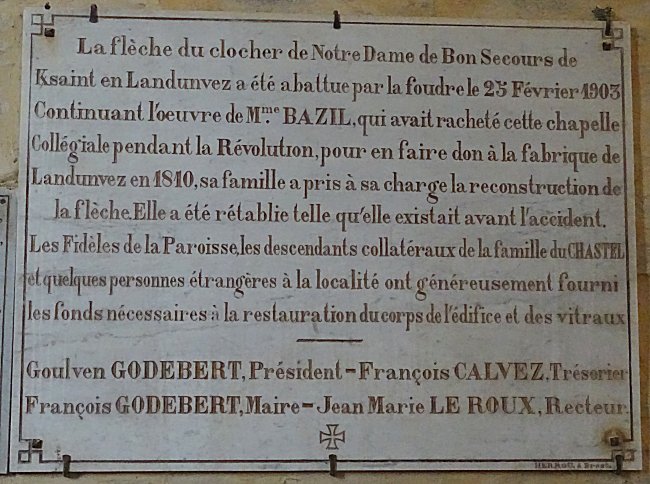
The nave
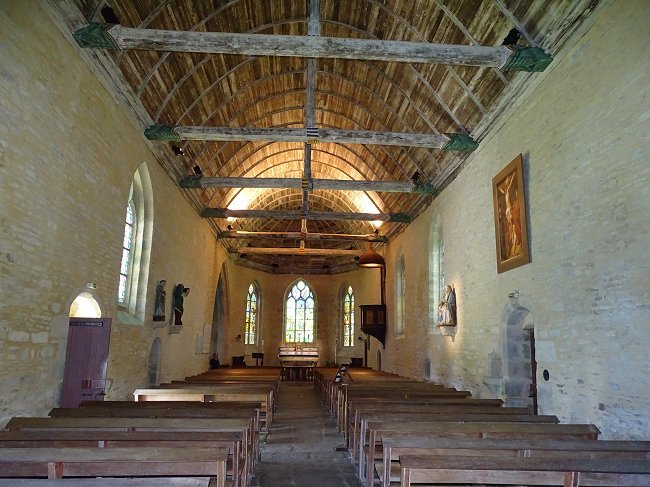
The church's interior is interesting. Upon entering, visitors are greeted by a large, recently restored Crucifixion painting.
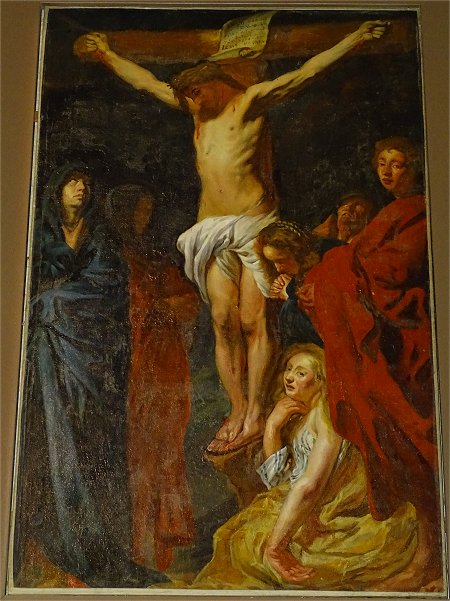
Ex-voto. A very fine copy of the work by the Dutch painter Jordaens ( 17th century )
currently on display at the Musée des Beaux-Arts in Rennes
Kersaint was an important centre for pilgrims. The legend of Sainte Haude and Saint Tanguy has always been the basis of their devotions
Read the tragic legend and description of the Sainte-Haude fountain :
It is recalled by the stained-glass windows of the master glassmaker Léon Payan2, which date from 1901.
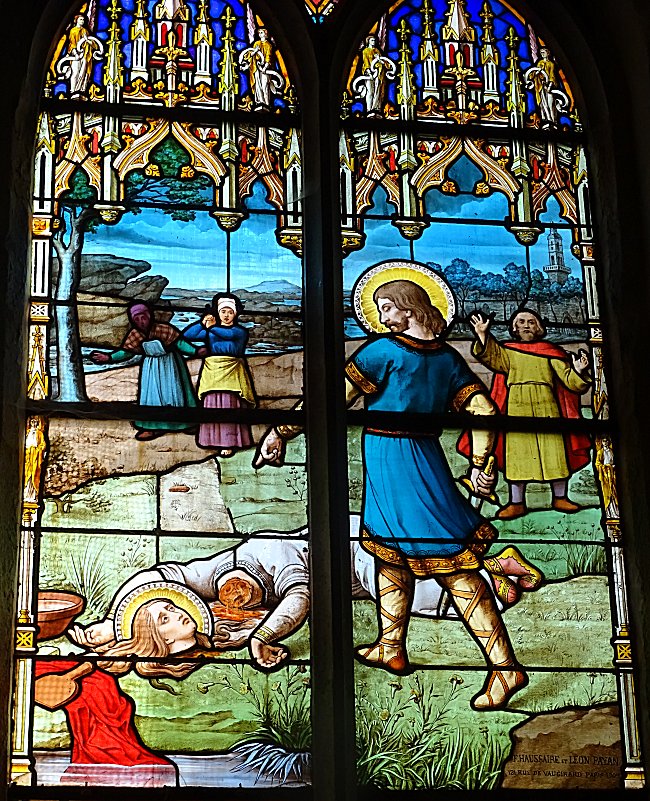
In front of this spectacle, two washerwomen are desolate while a bourgeois raises his arms to the sky.
This representation of a saint committing a fratricidal murder is quite surprising in a place of worship. But we must remember that his sister forgave him for his act and that the Gospels always advocate forgiveness.
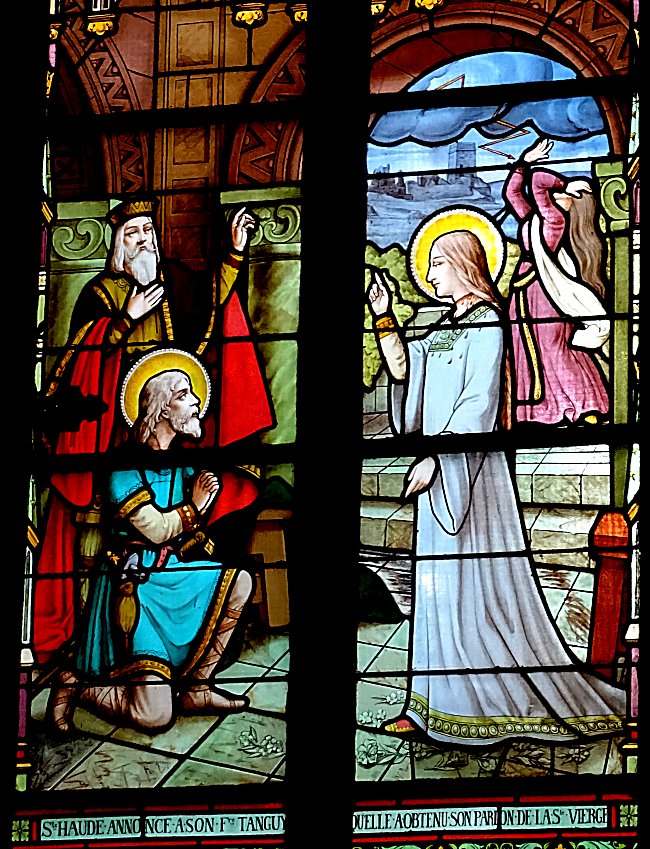
The saint bears under her face the mark of the sword that beheaded her.
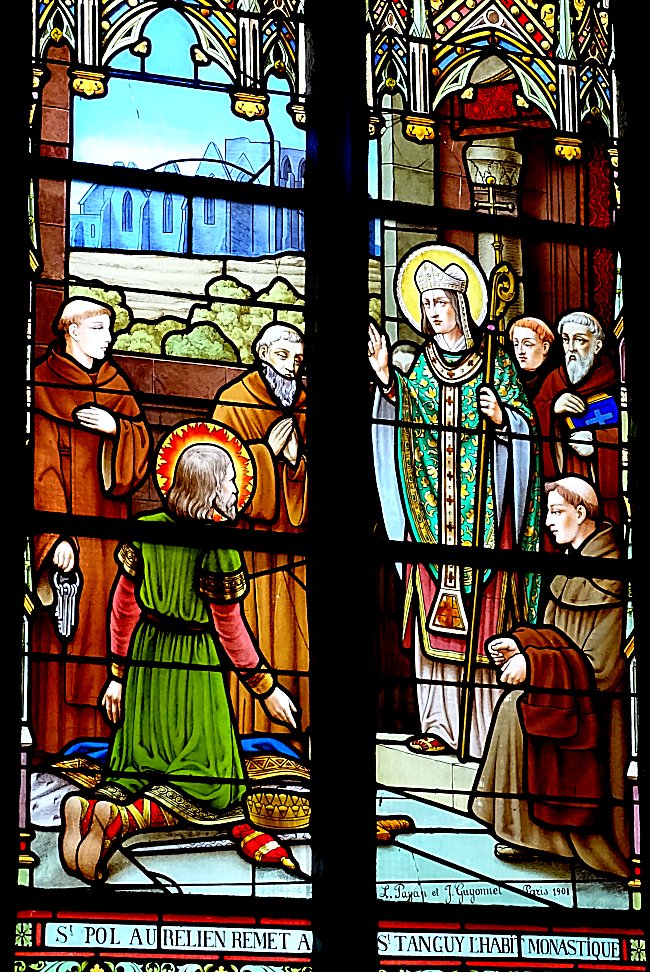
In the background we see St-Mathieu'abbey, which he later founded.
These stained-glass windows replaced those destroyed by the 1903 fire : They represented the five members of the du Chastel family who became bishops. Jean, Bishop of Carcassonne, founder of the chapel, Olivier and Gabriel, Bishops of Uzès, Olivier, Bishop of St-Brieuc and Hippolyte, Bishop of Tréguier.
On the walls of the nave two restored statues still remind the legendary founder of the pilgrimage.
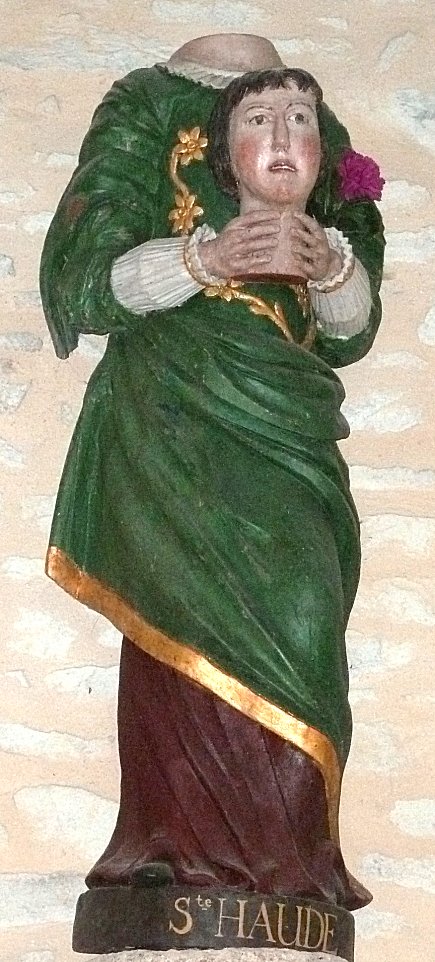
The saint carries in her hand the red flower that the legend says to bloom around the place of the murder and in the ditches of the castle.
|
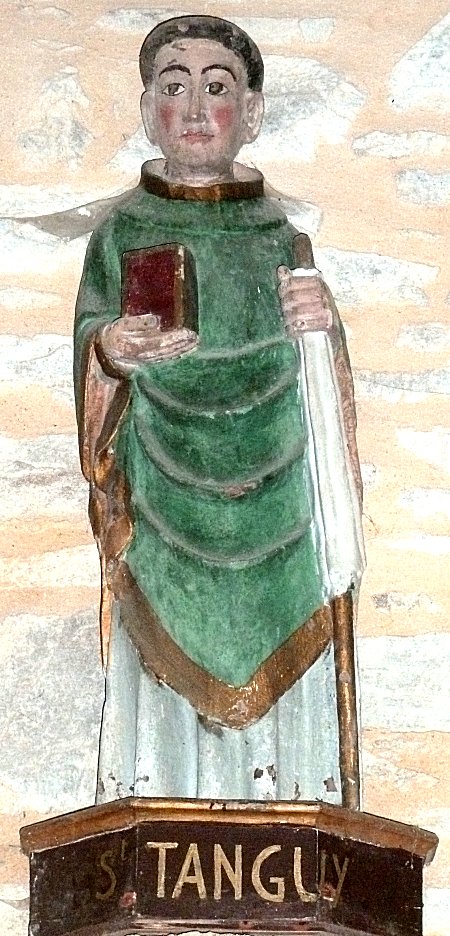
|
Restored in 1998, the chapel has benefited from extensive work on its frame, barrel vault, slate roof and walls. Since 2017, new work has focused on lighting and beautifying the interior. The coats of arms and engoulants on the beams, for example, are back in polychrome.
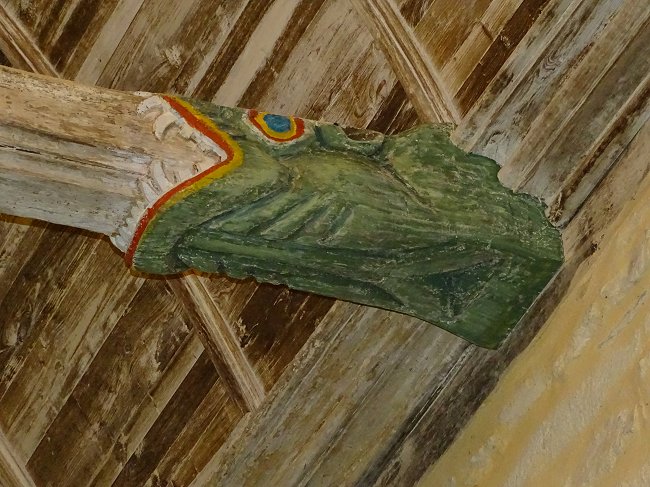
In the centre of the beams, we can still see the traces of several coats of arms, most of which illustrate the alliances of the lords Du Chastel of Trémazan with other noble families in Brittany. Heraldist Michel Mauguin has made a remarkable study of it:
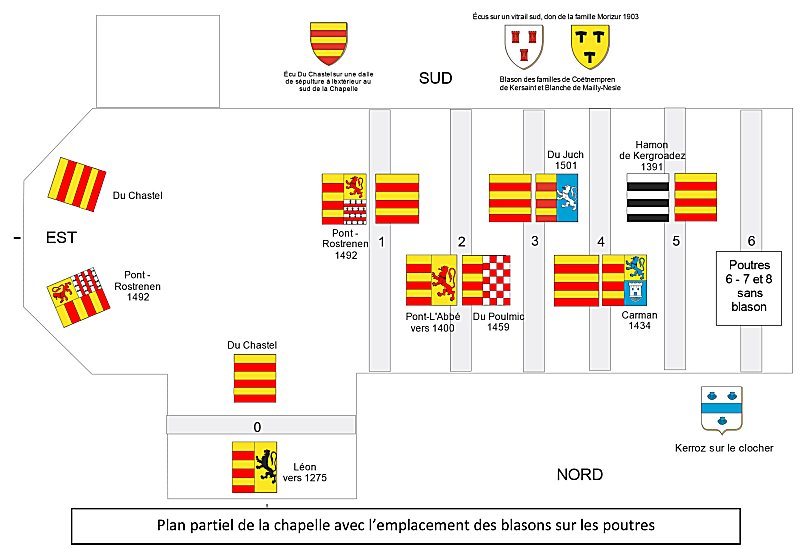
( Plan extracted from Landunvez heraldique by Michel Mauguin dec.2018)
Thanks to this map, the visitor will enjoy searching and identifying the traces of the other coats of arms. Here, for example, is one of those shown on beam 2 in the plan above, as it was before its restoration in 2022.
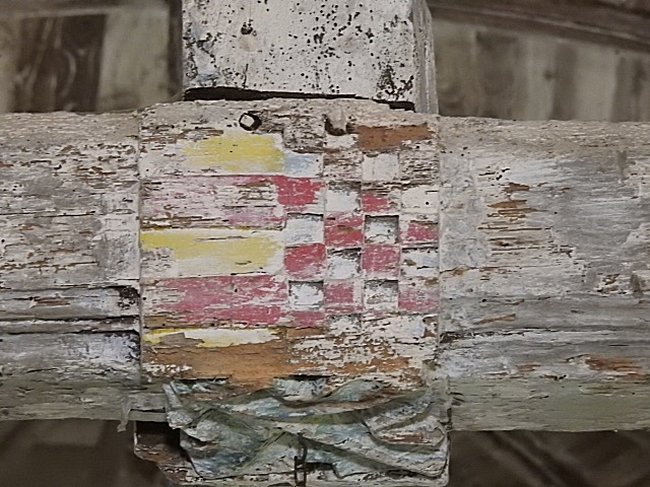
Photo A. du Chéné
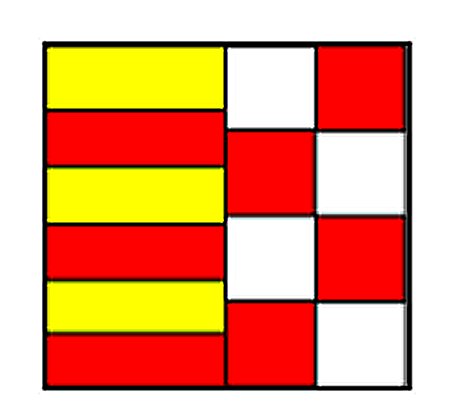
On the left are the coats of arms of Olivier du Chastel,
lord of Trémazan, and on the right those of Marie du Poulmic.
They were married in 1459, at the time of King Charles VII
( Heraldic research by Michel Mauguin)
The nave, quite simple, presents in its walls about twenty terracotta vases which were brought to light under the old coatings. This equipment gives the building an exceptional acoustic quality that allows the Kersaint-Landunvez Musical Cycle to organize series of renowned concerts every summer.
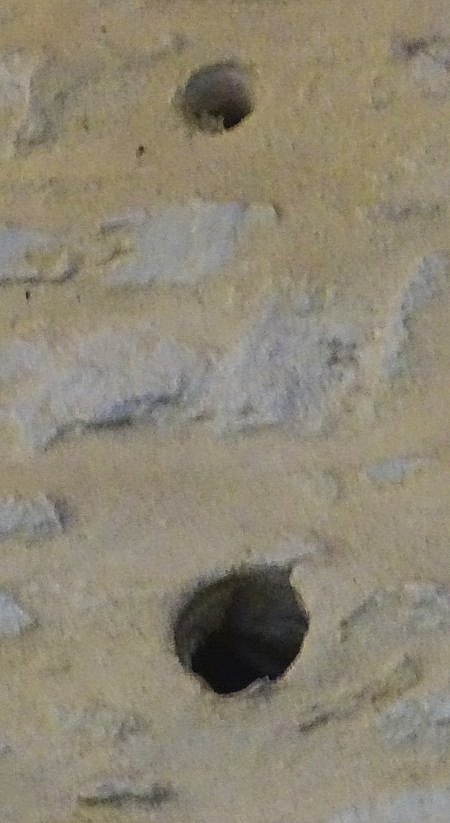
The chapel's past as a pilgrimage centre is recalled by the presence of a small lateral corridor, called the leper corridor, which allowed the sick to reach the chapel of the Virgin Mary directly, without being in contact with the other faithful. A small modern stained-glass window marks the old entrance.
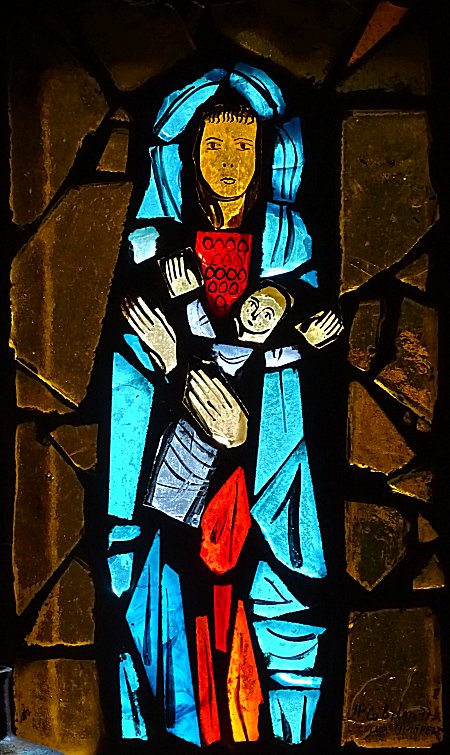
Two fireplaces even allowed pilgrims to warm up when they spent the night in the building.
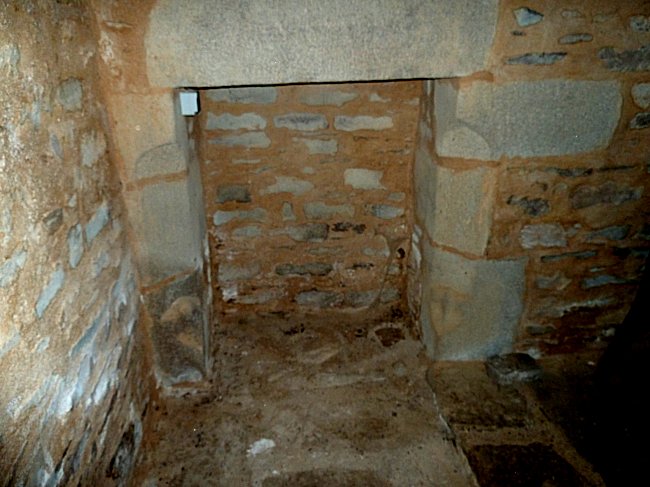
A large modern stained-glass window dominates the main altar with which it perfectly harmonizes.
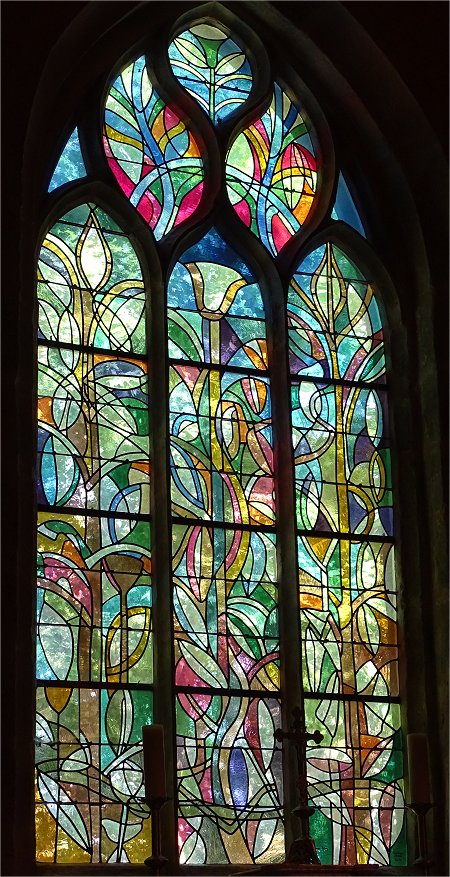
Produced by Antoine Le Bihan's workshops in Quimper
on a project by Hung Rannou
this master-window was installed in June 2017.
The outer foliage can even be seen waving in transparency, bringing the stained-glass window to life.

The recently restored high altar dates from the first half of the 19th century. In the shape of a curved tomb, its polychrome woodwork imitating marble covers the old stone altar. The same romantic style and floral decoration can be found in the Saint-Gonvel chapel.
To the right of the altar, above the sacristy door, three small paintings are on display.
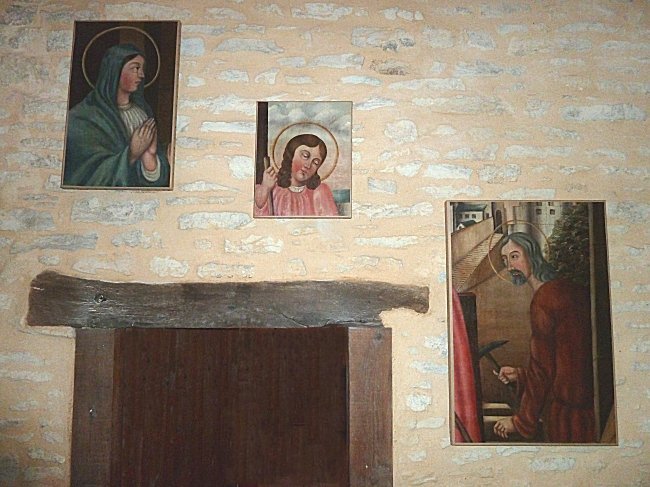
They come from a very damaged canvas representing the Holy Family, which adorned the sacristy and could no longer be restored.
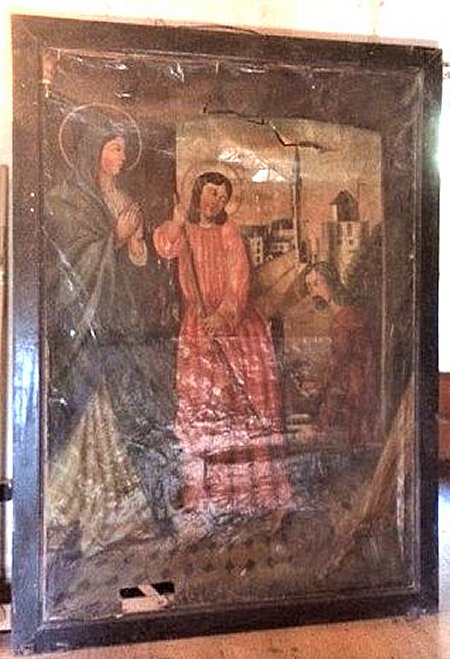
The Holy Family in the workshop. Ex-voto. Anonymous oil on canvas, 1843.
Photo A. du Chéné
The north wing of the building is dedicated to the Virgin Mary. Its large altarpiece, whose structure has been reworked and paintings restored, once overlooked the high altar. The central painting depicts the Assumption. Listed as a Historic Monument, as are the main altar of the choir and the altarpiece, it would be attributed to the painter Yann Dargent and dates from the beginning of the XIXth.
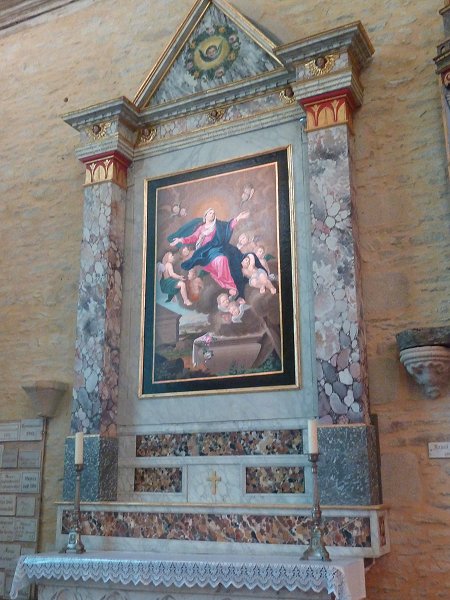
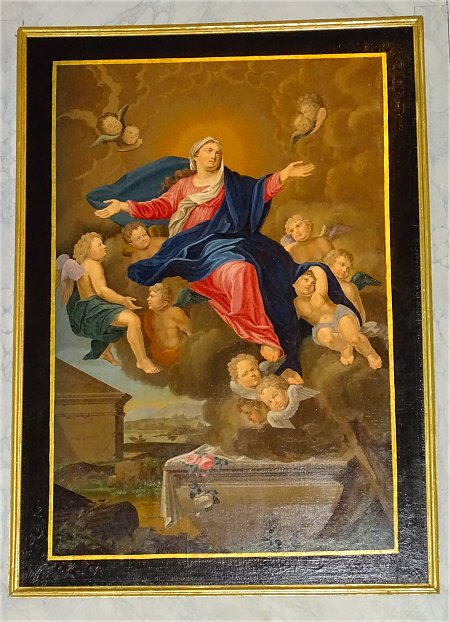
A very beautiful statue of Our Lady of Bon Secours and her Son, both crowned, is placed in a niche once closed by two wooden shutters.
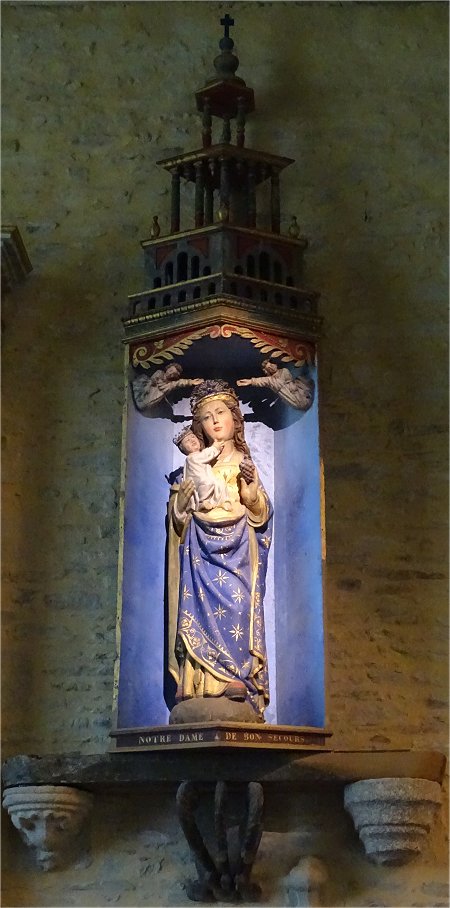
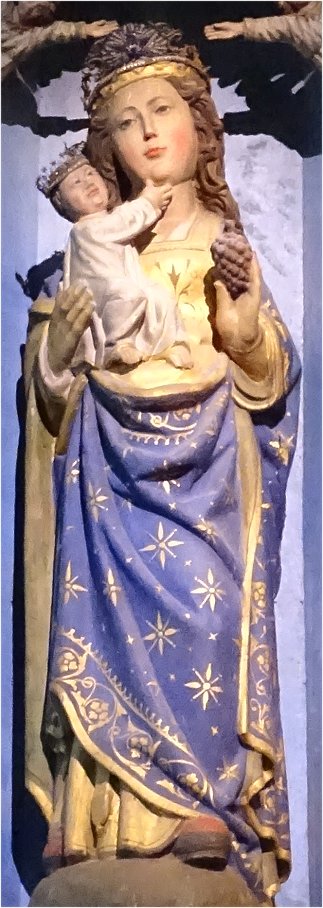
The Virgin is depicted holding out a bunch of grapes (or a pine cone?) to the infant Jesus. The crowns and the fleurdelisé coat recall their rank in the Kingdom of Heaven.
The Virgin, to whom the whole chapel is dedicated, is called here in Breton Itron Varia a Wir Zikour, literally Our Lady Mary of the Real Help The pardon of Our Lady of Good Help takes place every year on Ascension Day and August 15. The faithful are very numerous to participate.
To the left of this painting, a wooden statue intrigues the visitor:
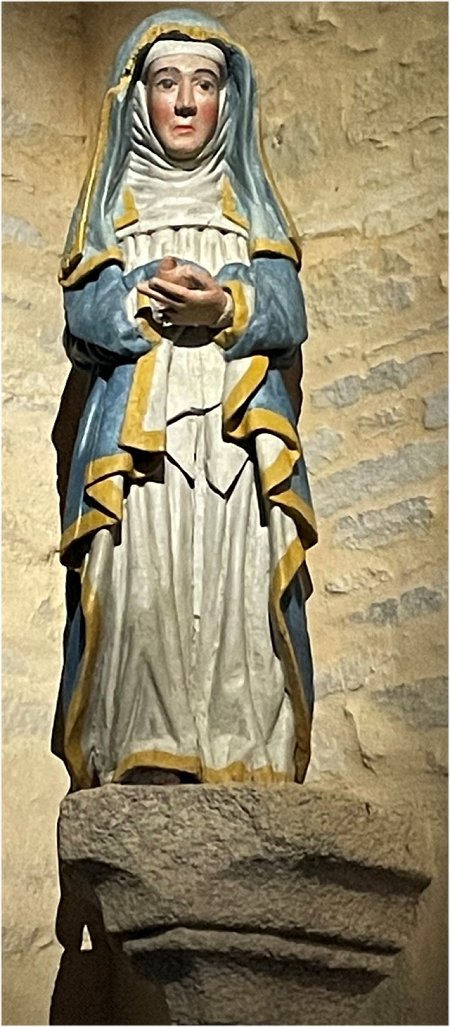
Photo A. du Chéné
This work, which has lost the fingers of its right hand and is referred to here as La Sainte Femme, is thought to be a Mater Dolorosa.
Three models of sailing ships, each donated to the chapel as an ex-voto following a vow, remind visitors of the difficult sailing conditions in the Iroise Sea.
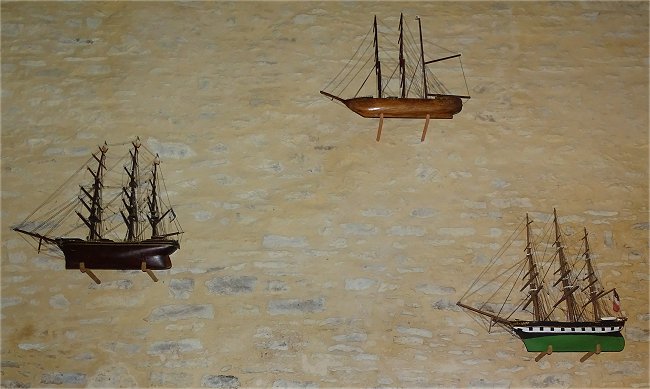
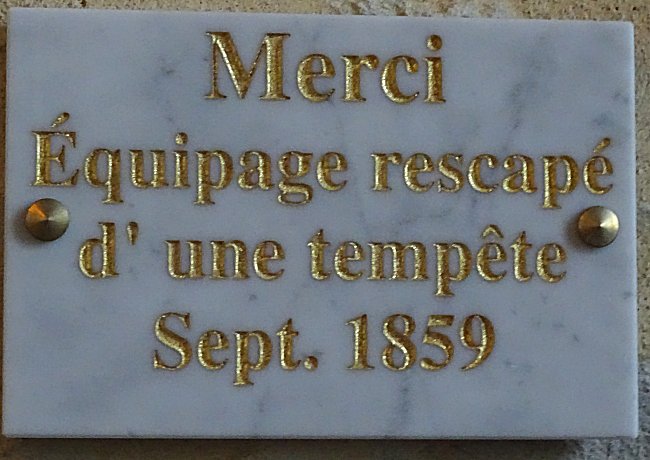
The above plaque was erected in response to a wish expressed by the captain of a merchant sailing ship and his matalots. A violent storm had brought them very close to the reefs of the coast. The danger was imminent, the sailboat was about to break.
"- Let's promise Our Lady of Kersaint to go see her tomorrow if she pulls us out of here," said the captain.
And a wave stronger than the others threw the ship over the rocks. The next day, they came as promised, bareheaded and barefoot, to thank Our Lady of Bon Secours.
In the corner, numerous plaques of thanks to Notre Dame de Bon Secours demonstrate the gratitude that pilgrims and parishioners have always shown her.
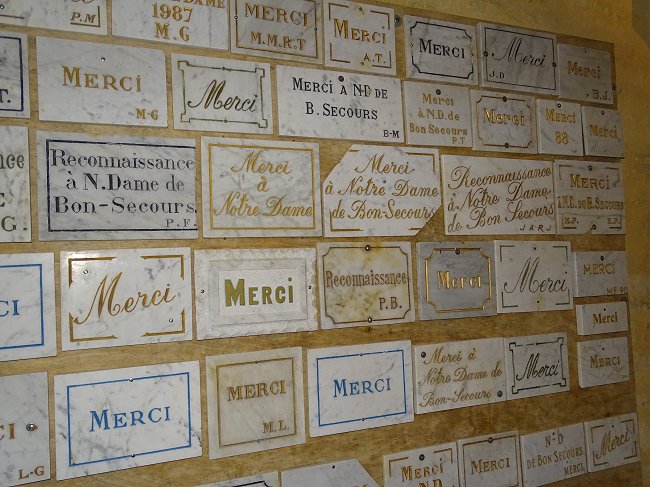
Another statue is placed against the south wall of the nave. It represents Saint Anne, mother of the Virgin and grandmother of the child Jesus. Saint Anne is the patron saint of Brittany.
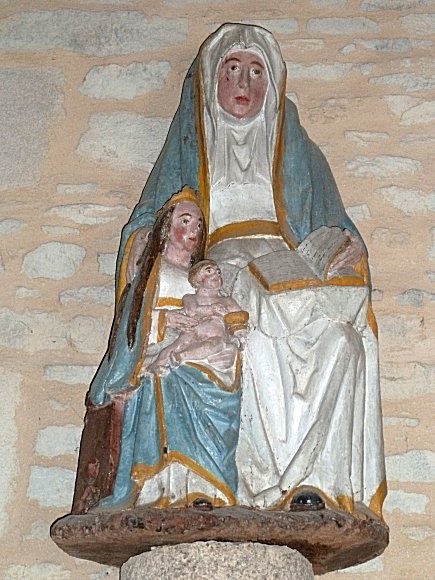
Nearby, a preacher's pulpit stands out from the crowd. The canons reached it by a small door giving on a staircase placed in the sacristy.
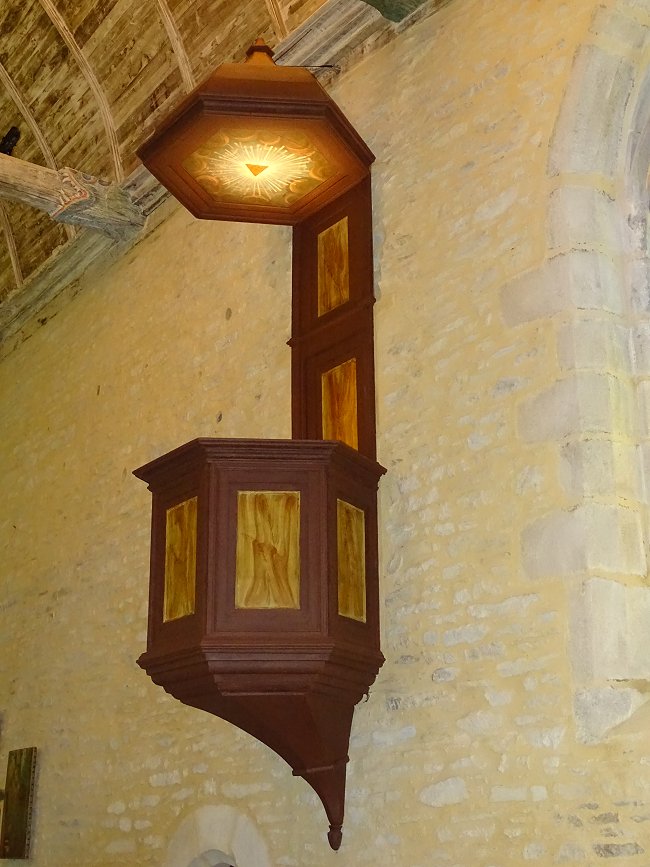
Finally, at the far end of the nave, not far from the confessional, is the baptismal font at the foot of a final wooden statue of Christ blessing.
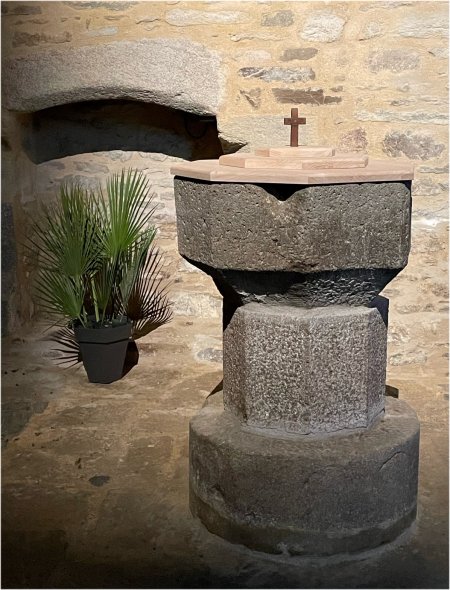
Photo A. du Chéné
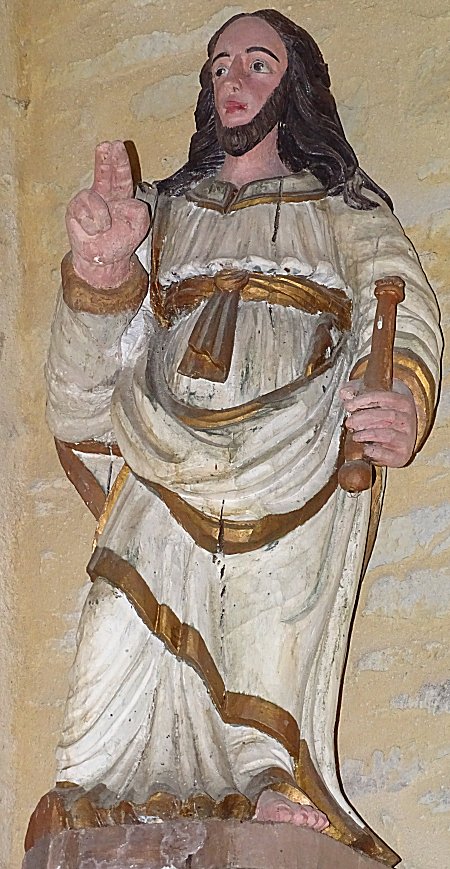
-1- The ruins of the castle of Trémazan are located 500 m from the chapel. A page of this website is dedicated to them.
Léon Payan designed and made the stained glass windows of a large number of churches and chapels in Brittany. For more information on this artist and his work, see below the highly documented website dedicated to him.
***
READ MORE
Do not miss to visit the site of
the Association for the Safeguarding of the Landunvez Chapels
Print the itinerary below to discover other places recalling the legend of Saint Haude and Saint Tanguy:
Click on these two pictures to download it
***
- "La chapelle de Kersaint, Notre Dame du Vrai Secours".
- Abbé Ernest Appéré : "Notice sur Notre-Dame de Kersaint", Impr.Le Grand, Brest, 1936.
Concerts are organized every year in the chapel during the summer season. See on this website the section : Animations and festivals .




